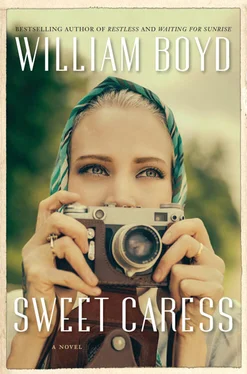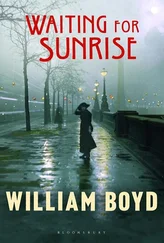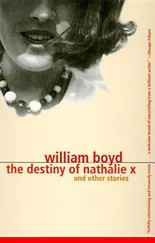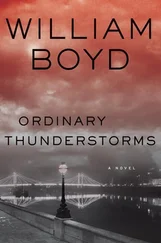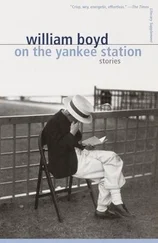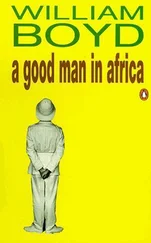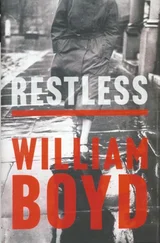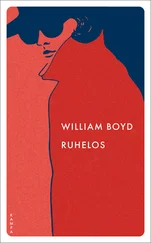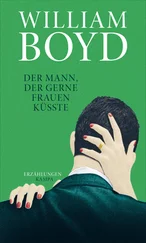Again I saw the man in the pale grey suit and I shouted over to him.
‘Hey! Listen! I work for an American magazine!’
I realised almost as soon as I’d spoken that, as far as these men were concerned, I might as well have said, ‘I work for a Jewish magazine.’
‘Get the fucking camera!’ the man in the pale grey suit ordered.
One of the young blackshirts grabbed my arm. He had a snub nose and flushed pink cheeks, excited, angry.
‘Gimme the camera, Jewish bitch!’
‘No!’ I shouted back. ‘Let me go!’
I flung a glance behind me, looking for the man in the pale grey suit as if he were some potential source of reason amongst all this unreasoning anger, but he seemed to have disappeared. From beyond St Dunstan’s I could hear the baying of voices on Maroon Street as the march advanced.
Then three of the blackshirts seized me. My bag was snatched, my camera found, opened, the film ripped out and exposed.
Snub-Nose slapped my face, hard, enough to make my hat fall off, snapping my head round, and I cried out in pain.
‘Jewish Red whore!’ he shouted at me and I felt his spittle fleck my cheeks.
I was thrown to the ground. I saw boots stamping on my camera, crushing it to pieces. I could hear police whistles, now, loud and shrill above the clamorous low baying of the mob in Maroon Street, and, ringed as I was by these young men standing above me, looking down on me, I could sense their uncertainty, their anxiety. Police were drawing near, they didn’t control the streets yet, these blackshirts, unlike the Nazis in Berlin — law and order still prevailed in London in a fragile way. I sensed their urge to turn and run, saw them look this way and that, uneasily.
‘Teach her a lesson, lads!’ Snub-Nose shouted as the crowd around me began to thin and drift away, seeking safety. He spat at me. Then one of his friends, almost as an afterthought, kicked me in the arm. That first kick unleashed something in the others and half a dozen or so began to hit at me with their fists as I lay on the ground, thwacking me with their clubs. I rolled into a protective ball, folding my arms around my head — don’t kick me in the head was the chant keening in my brain, don’t kick my head — but I left my back exposed, curved and defenceless and a blow to the kidney made me unfold reflexively, arching in pain and, just at that moment — vulnerable, supine — Snub-Nose kicked me in the stomach, low and very hard, and I felt something crack and give in me. I couldn’t ‘roll with the punch’ as I was worried about the spearing pain in my back and when the toe of his jackboot connected with my lower abdomen I felt it sink in deep and do its damage.
I was now semi-conscious and blood was beginning to flow across my face from a cut above my eye. I clutched at my belly with both hands — my wounded belly — and screamed an atavistic howl of agony. It made them recoil and back away as if I had the plague.
‘You done it now, Lenny,’ I heard someone dimly say as the world went dark and blurry. Then there were police whistles, like shrill violent birdsong, until, all of a sudden, I was aware of Lockwood’s voice in my ear saying, ‘You’re safe, Amory, you’re safe. Don’t worry, we’re going to take you to hospital.’ And that was that.
*
THE BARRANDALE JOURNAL 1977
The Maroon Street Riot — or Skirmish, or Affray, as it was variously referred to — was overshadowed two months later by the famous ‘Battle of Cable Street’ in October when thousands of Eastenders blocked and then repelled a huge march by Mosley’s blackshirts and some thousands of BUF supporters. Six thousand police were in attendance that day and fought the anti-fascist crowd. The blackshirts, thwarted, turned away from the East End of London and were ruefully dismissed by Mosley at Charing Cross Bridge and that rebuff, that defeat, it can be argued, saw the end of any real continental-style fascist movement in Britain. However virulent the message that continued to be delivered by Mosley and his acolytes, the fact was that the British Union of Fascists never won control of the streets in London and perhaps that’s what sapped their morale and saved us.
It has to be said that I was completely unaware of anything else taking place for the rest of 1936 — such as the course of the Spanish Civil War or the abdication crisis, Roosevelt winning a second term, or the beginning of the Rome — Berlin Axis pact — as I lay in a ward in the London Hospital in Whitechapel. It was felt to be ‘too dangerous’ to move me, the doctors advised, and who was I or anyone else to disagree, given the severity of my condition after the beating I had received?
However, Global-Photo-Watch had its pictures, all taken by Lockwood, and so, capitalising on this exclusive, they duly ran a special issue of the magazine. The world was alerted to the sinister potential of the British Union of Fascists and something of a stir ensued, I learned later. Lockwood made a name for himself and was swiftly employed as a senior photographer by the Daily Sketch but, as I say, all this passed me by at the time.

My medical problem was clear enough: I was suffering from near-constant, stop-start bleeding from my vagina as a result of that final kick delivered by Snub-Nose Lenny. I’d lie in bed for two days without any problems, thinking everything had calmed and then wake in the morning with my sheets drenched in vivid red.
I had three blood transfusions before the year ended but they seemed to make no difference at all. I wore a form of padded nappy-cum-elasticated-rubber-knickers device that managed to contain the bouts of bleeding and save any gross embarrassment but, as the months passed, I became steadily weaker. The doctors who stood deliberating around my bedside had no solutions for me. Diet and rest were all they could prescribe. I ate nothing but bland foods — junket, blancmange, rice and suet puddings, potato cakes and milk dumplings — as if anything tasteless and vaguely pale could stem the ceaseless sanguine flow.
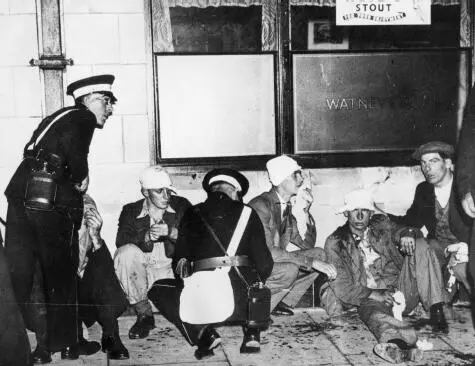

Images from the Maroon Street Riot, 1936 (photographs by Lockwood Mower).
Nevertheless, in the spring of 1937 I was estimated to be well enough to be moved to a cottage hospital near Lewes called Persimmon Hall, closer to home. And, once there, I did seem to begin to recover my health slowly, sitting on a bench in the garden on sunny days (wearing my heavily padded rubber nappy) where I could receive visits from friends and family. I was still very underweight, despite my milky, creamy diet, anaemic and continually tired but, I told myself, I was finally on the mend. Lockwood came and recounted the full story of my rescue — and thanked me profusely for the proper job with the Sketch that had ensued after his photographs were published. Faith Postings came and told me of the motorcycle dash to Southampton with Lockwood’s photographs and negatives. My mother and Xan were my most regular visitors and even my father came by from time to time, though I sensed the quiet trembling of unease in him, despite his constant smile, unconsciously unhappy at finding himself in a hospital environment again. Dido sent a vast bouquet of flowers once a week. Greville came and made me laugh. Then Faith Postings popped in one day and told me the GPW office was being closed down.
Читать дальше
